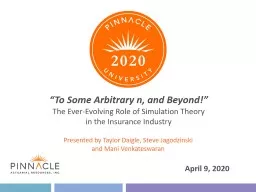

The EverEvolving Role of Simulation Theory in the Insurance Industry Presented by Taylor Daigle Steve Jagodzinski and Mani Venkateswaran Agenda Simulation Introduction ID: 931321
Download Presentation The PPT/PDF document "“To Some Arbitrary n, and Beyond" is the property of its rightful owner. Permission is granted to download and print the materials on this web site for personal, non-commercial use only, and to display it on your personal computer provided you do not modify the materials and that you retain all copyright notices contained in the materials. By downloading content from our website, you accept the terms of this agreement.
Slide1
“To Some Arbitrary n, and Beyond!”The Ever-Evolving Role of Simulation Theoryin the Insurance Industry
Presented by
Taylor Daigle,
Steve
Jagodzinski
and
Mani
Venkateswaran
Slide2AgendaSimulation IntroductionUses of SimulationCommon Simulation TechniquesMonte Carlo Simulation (MCS) BriefingMCS Example 1 - Deductible FactorsMCS Example 2 – Aggregate Loss Distribution
More Industry Connections
Expected Adverse Deviation
Future of MC Implementation
Closing Remarks
Slide3Background - Simulation IntroductionGeneral Procedure:Outline possible outcomesLink each outcome to a random number or set of numbersSelect a random number from source
Note the simulated outcome attached to number selected
Repeat steps 3 and 4 a lot
Analyze simulated outcomes, assess results
Slide4Background - Uses of SimulationPredictive analytics domainNew ASOP 56Prevalence in the reinsurance industry
Impacts of catastrophes and adverse scenarios
Claim severity, frequency or aggregate
l
oss
d
istribution
m
odeling
Stochastic reserving
Slide5TheoreticalBackground - Conventional Simulation Techniques
Pseudo-random
u
niform
n
umber
g
eneration
Assuming an a, c, m and some X
0
or starting seed: Xn+1 = (aXn + c) mod mInverse transform methodAssuming underlying probability distribution and parametersInverting CDF, solving for x given u: xi = F -1(ui)Acceptance/rejection methodIterative process of accepting a yi conditioned that some , where Monte Carlo - to be continued
Practical
Slide6History of MCSPartially invented by Stanislaw UlamPolish scientist who participated in Manhattan ProjectPlaying solitaire while recovering from surgery, wanted to predict probability of winning a handCombinatorics was too complex so thought about the possibility of simulating the game
ENIAC computer made this computationally possible
Paper published on Monte Carlo in 1949
Slide7Method of parameter estimationRandom sample information to make inferences about the populationLaw of large numbers“As the number of identically distributed, randomly generated variables increases, their sample mean approaches their theoretical mean”Overview of MCS
As variance grows, we need a larger sample to have the same amount of confidence
Slide8Advantages/Disadvantages of MCSAdvantages:Incredibly powerful in data creation, analysis and visualizationAlleviates issues that may result from a small sample sizeDisadvantages:Difficult to replicate, can be computationally expensive
Still relies on distribution assumptions, parameters chosen
Slide9MCS Model Example 1Deductible FactorProportion of claims above the deductibleSimulated n number of claims via LogNormal distributionExpectation?Discounts should converge at some number of iterations
Slide10Example 1 (Cont.) - Deductible Factors
Slide11Example 1 (Cont.) - Discount ConvergenceDiscount convergence relative to n = 1M
Slide12Example 1 (Cont.) - Parameter ConvergenceParameter convergence relative to theoretical
Slide13Example 1 (Cont.) - Parameter ConvergenceMean converges“As the number of identically distributed, randomly generated variables increases, their sample mean approaches their theoretical mean”
Standard deviation does not readily converge
Slide14Example 1 (Cont.) - Model EvaluationQ-Q plot at 10k iterationsSampled data matches theoretical distribution
Slide15Example 1 (Cont.) - Model EvaluationQ-Q plot at 10k iterations fitted to GammaPerforms visibly worse than lognormal but still not a bad guess
Slide16MCS Model Example 2Aggregate loss distributionDistribution of aggregate dollar loss of all events in a given yearSimulated n number of years of dataNumber of claims simulated using a Poisson distributionSeverity simulated using LogNormal and Gamma distributions
Parameters chosen to equate the means and variances of
LogNormal
distribution to Gamma
Limit of $100k per occurrence
Expectation?
NO...EXPLORATION!
Slide17Example 2 (Cont.) - R Code
Slide18Example 2 (Cont.) - Percentiles
Slide19Example 2 (Cont.) - Variation Around the MeanUncertainty from variance diminishes as n becomes sufficiently large80 to 82% decrease in CI width from 500 to 10,000 simulations
Slide20Example 2 (Cont.) - Variation Around the Mean
Slide21Example 2 (Cont.) - Variation in the TailModeling error at the 99th percentile reduced to 1% at approximately 115,000 simulations
Slide22FindingsPower of the law of large numbersMC is an efficient method of building confidence around data insightsConfidence around the mean converges rather quicklyImportant to have a stable estimate of average losses from insurer’s perspectiveConfidence in the tail takes a bit longerRelevant to insurers (determining risk appetite) and reinsurers alike
Slide23More Industry Connections...
Slide24Expected Adverse DeviationDef: Average amount of loss an insurance company incurs beyond its expected losses or amount of expected adverse deviation (EAD) an insurer is exposed to. EAD = E[max(X - E(X),0)] EAD Ratio =
EAD
(X) / E(X)
Weighted average of outputs from MC simulation
Aims to quantify internal risk distributions
Ratio measures how much volatility and risk a company takes on
Slide25Future of Monte CarloContinued use in predictive analyticsStock price fluctuationTime series combined with Monte Carlo Stochastic reserving
Slide26Questions? ? ? ?
Slide27Thank You for Your AttentionTaylor Daigletdaigle@pinnacleactuaries.com
Steve Jagodzinski
sjagodzinski@pinnacleactuaries.com
Mani
Venkateswaran
mv1492357@gmail.com
“There is something irreversible about acquiring knowledge; and the simulation of the search for it differs in a most profound way from the reality.”
- J
. Robert Oppenheimer
Slide28Works CitedCiesielski, Krzysztof, and Themistocles M. Rassias. “Stan Ulam and His Mathematics.” The Australian Journal of Mathematical Analysis and Applications, 2009,
ajmaa.org
/
searchroot
/files/pdf/
v6n1
/
v6i1p1.pdf
.
Meyers, Glenn. “Stochastic Loss Reserving Using Bayesian
MCMC Models.” Casualty Actuarial Society, 2015, www.casact.org/pubs/monographs/papers/01-Meyers.PDF.Pease, Christopher. “An Overview of Monte Carlo Methods.” Medium, Towards Data Science, 11 Sept. 2018, towardsdatascience.com/an-overview-of-monte-carlo-methods-675384eb1694.Sigman, Karl. “Acceptance Rejection Method.” Columbia.edu, 2007, www.columbia.edu/~ks20/4703-Sigman/4703-07-Notes-ARM.pdf.“Stat Trek.” Simulation in Statistics, stattrek.com/experiments/simulation.aspx.Walling, Rob. “Expected Adverse Development as a Measure of Risk Distribution.” Pinnacle Actuarial Resources, 2018, pinnacleactuaries.com.Wicklin, Rick. “The Inverse CDF Method for Simulating from a Distribution.” The DO Loop, 22 July 2013, blogs.sas.com/content/iml/2013/07/22/the-inverse-cdf-method.html.